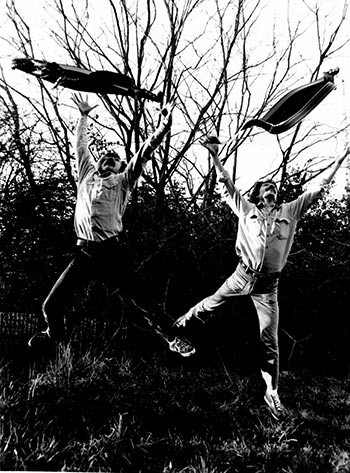Wellyn
Author: Robert Force
Date/Studio: 1981 Spectrum, Portland, OR
Engineer: Dave Mathew
Producer: Baila Dworsky
Original Release: The Art of Dulcimer (KM217)
Current Release: The Complete Recordings (BSR 158)
 “Hard driving dulcimers for a laconic Connecticut afternoon” was the one-line description for Wellyn on the back of the Pacific Rim Dulcimer Project album when it came out in 1977. That's what was done in those days-- include a pithy nugget radio DJs could use when they played the song. However, rather than conquering the AM airwaves, it turned out Wellyn was bound for a different musical path.
“Hard driving dulcimers for a laconic Connecticut afternoon” was the one-line description for Wellyn on the back of the Pacific Rim Dulcimer Project album when it came out in 1977. That's what was done in those days-- include a pithy nugget radio DJs could use when they played the song. However, rather than conquering the AM airwaves, it turned out Wellyn was bound for a different musical path.
Some tunes have a life of their own. Little did I know in the summer of 1972 when I wrote it, such a destiny was in store. I was in the front yard of Al's and my house in West Cornwall, CT experimenting with using full-barre, “power chord” progressions and an exciting tune was starting to unfold. I rushed over to where Albert was also working out tunes and said, “Hey, Flaco, I got a new tune!” He replied, “Me too!” I played mine; he played his. We collaborated on a bridge for each tune and on that laconic summer day, two seminal tunes for Appalachian dulcimer came into the world, Cornwall and Wellyn.
From the vantage of 40 years later I can look back and see the physical outline of how this “life of its own” came to be. Albert developed a complimentary full-barre style and Wellyn became a regular part of our shows right away. It was recorded on the Pacific Rim Dulcimer Project, the first dulcimer lp to receive wide-distributorship. The PacRim album had a wide audience appeal through showcasing many genres of music and the individual styles of six players. All six had a vested interest in getting their work out so exposure was multiplied by that factor since we all toured independently.
Pacific Rim Dulcimer Songbook, the first book ever published with tablature invented for the dulcimer, accompanied the album the next year. The book made it possible for players who wanted to learn a “dulcimer” song to not have to do so by ear alone. They didn't have to experiment with how the chords or melodies were formed; the book showed them how. The PacRim Songbook was independently co-published by the authors. A higher potential for direct-sales profit meant that in the “be scrappy and hustle” days of indy folk music there was an incentive for each artist to sell the album and the book.
The subjective side is... well, subjective. Wellyn appealed to people. They liked the melody. It was fun to play. They liked the athleticism of quick chord changes and its driving, exactly-timed rhythm. Being able to play Wellyn exhibited the personal mastery of a complicated piece of music. It had room for two players to play parallel parts. It was also open to interpretation. As its popularity grew and lots of people knew the tune, it became one folks could teach each other and bring out during song circles.
All these factors combined to allow Wellyn to have a life of its own. Over the years others have recorded it on their albums, from exact copies to wah-wah, electric rock and roll. It has appeared in several anthologies. Anthropologist, Robert Nichols, wrote a treatise tracing Wellyn's transition from being a self-song to a community endeavor to a societal song and back to (somebody else's) individual song. (With permission, his treatise is in the Pythagoras and Other Writing section of this website.)
Nichols uses the specialized language of anthropology. It is not a light read. But throughout is a simple, yet profound idea best illustrated when he writes, “In any community there exist songs or works of art that become important of themselves, creating an acceptance that allows the community a focus point for creation of folklore... 'a kind of bank where authenticity is safely stored'...”
After Albert died I was “off tour” for ten years. When I started again in 2000, I came across people playing the tune who had no idea where it came from. It had moved on from being my song. Wellyn now belonged to everyone who had made it their song. Al and I recorded two versions; the second one is longer because we play it through three times. Dozens of other folks' renditions exist in cyberspace.
